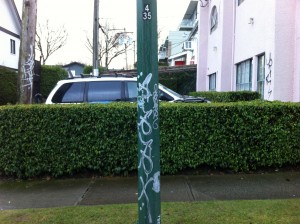Alex Cynader
I have walked past this trio of tags well over a hundred times; it is right across the street from my house, where my car is parked, where I walk to catch the bus, yet it never caught my eye until two days ago when I thought to look. Many people raise the idea that graffiti is a type of modern art, with a meaning behind it (c.f. Rafferty, Discourse on Difference), but by taking no notice of these squiggly lines it beg the question, is graffiti causing any social effects when its existence is going unnoticed? The distinction must be drawn, then, between the three ‘tags’ pictured above, and the arguably more organized and socially-influential medium of ‘street art’ done by ‘writers’. Faye Docuyanan raises the interesting delineation between graffiti artists in an essay on its illegality, Governing Graffiti in Contested Urban Spaces. She notes that, “taggers, often emphasize quantity over quality, and write primarily to obtain fame among their peers. Writers, on the other hand, place more emphasis on the development of skills and style and spend significant amounts of time planning and creating elaborate productions” (Docuyanan, 103). While this helps distinguish the two types, it arguably produces more questions of whether either types should be legal: does the method Docuyanan describe not sound the same as any respected artist? In Vancouver, it is difficult to see the harm in any graffiti, indeed, the most you see are small tags. Yet, every now and then you will stumble across a beautiful mosaic of street art, ought this be illegal? Who is it harming to have a free mural painted in an otherwise gritty area of town? It seems graffiti is an area in which more and more questions are popping up, and while the answers are not obvious, it is hoped that neither are decisions on its legality.
PoLAR: Political and Legal Anthropology Review. . Docuyanan, Faye: Governing Graffiti in Contested Urban Spaces.

